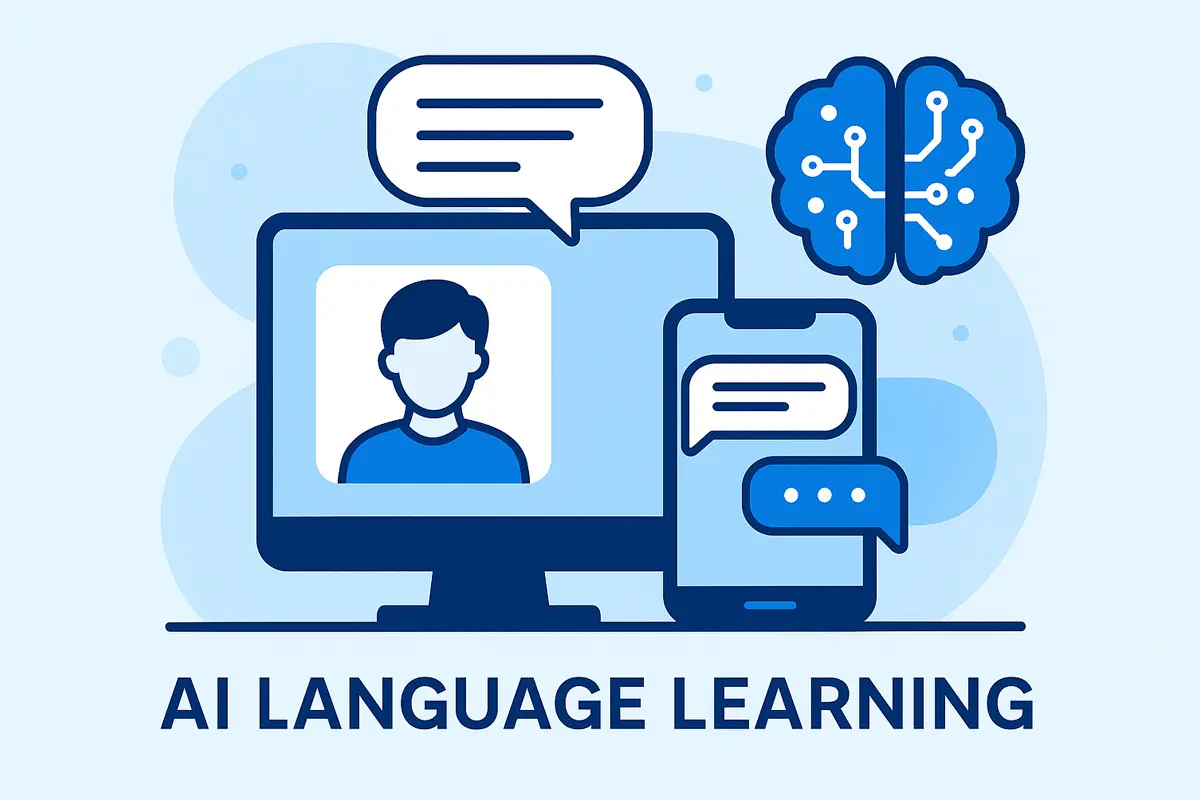
AI language learning uses artificial intelligence, like chatbots, speech tools, smart apps, and avatars. This helps make learning a language faster and easier. Instead of just books or classes, AI now acts like a 24/7 tutor. It gives instant corrections, creates lessons that fit your level, and lets you practice speaking in real time.
1. What Is AI Language Learning?
AI language learning uses technology to help people study.
- NLP (Natural Language Processing): Helps apps understand what you write or say.
- Speech Recognition: Checks if you pronounce words correctly.
- Text-to-Speech (TTS): Reads words to you in a natural accent.
- LLMs (like ChatGPT): Let you chat and practice conversations.
These tools can adapt lessons to your progress and give feedback on the spot.
2. How AI Changes the Way We Learn
AI improves language learning in four key ways:
- Assessment: It tests your level and gives a plan.
- Adaptation: Lessons change as you improve.
- Simulation: Lets you role-play daily life, like ordering food or asking for directions.
- Correction: Fixes mistakes right away, without waiting for a teacher.
💡 Example: An AI avatar can respond when you say gracias wrong and help you say it correctly.
3. Benefits of AI Language Learning
| Feature | Traditional | AI Learning |
|---------|-------------|-------------|
| Feedback | Slow | Instant |
| Personalization | Same for all | Tailored to you |
| Availability | Limited hours | Always on |
| Cost | Expensive | Low or free |
| Engagement | Static | Fun & interactive |Extra benefits:
- Confidence → Practice without fear of mistakes.
- Immersion → Apps use real slang, songs, and culture.
- Motivation → Games, streaks, and challenges keep you practicing.
4. Popular AI Language Learning APP
- Avatalks → AI avatars for immerse learning.
- Duolingo Max → Role-plays and AI explanations.
- ELSA Speak → Helps with speaking.
- ChatGPT → Open conversation practice.
- Memrise → way to memorize words.
📌 Utilize multiple instruments. Mix apps for grammar, speaking, and listening.Check this post to view the 2025 Guide for AI Language Learning
5. AI Tutors vs Human Tutors
| Aspect | AI Tutors | Human Tutors |
|--------|-----------|--------------|
| Availability | 24/7 | Fixed times |
| Speed | Instant | Slower |
| Culture | Limited | Deep |
| Connection | Low | High |
| Cost | Low | Higher |👉 The best way is blended learning: AI for daily drills, humans for culture and personal feedback.
6. AI in Classrooms
Teachers use AI to:
- Make lesson plans and quizzes.
- Grade homework faster.
Students use AI to:
- Chat with bots for practice.
- Get study paths that fit their level.
- Improve speaking with speech recognition.
7. How to Get Started
- Pick a good app → Choose one with speech feedback (Avatalks is great).
- Set small goals → Try 15 minutes a day.
- Use role-play → Practice booking tickets or ordering food.
- Track progress → Many apps give reports.
- Stay consistent → A little each day beats cramming.
8. Challenges & Future
Challenges:
- AI lacks human warmth.
- Needs internet and devices.
- Some apps collect data, so check privacy.
Future trends:
- Custom AI tutors.
- AR + AI for virtual practice.
- Real-time translation glasses.
9. Final Thoughts
AI language learning is already here. From chatbots to AI avatars like Avatalks, learners can practice anytime, anywhere for your target language.
The smartest approach is mixing AI tools with human interaction. That way, learning becomes faster, smarter, and more fun.